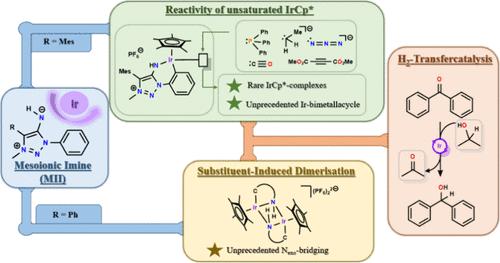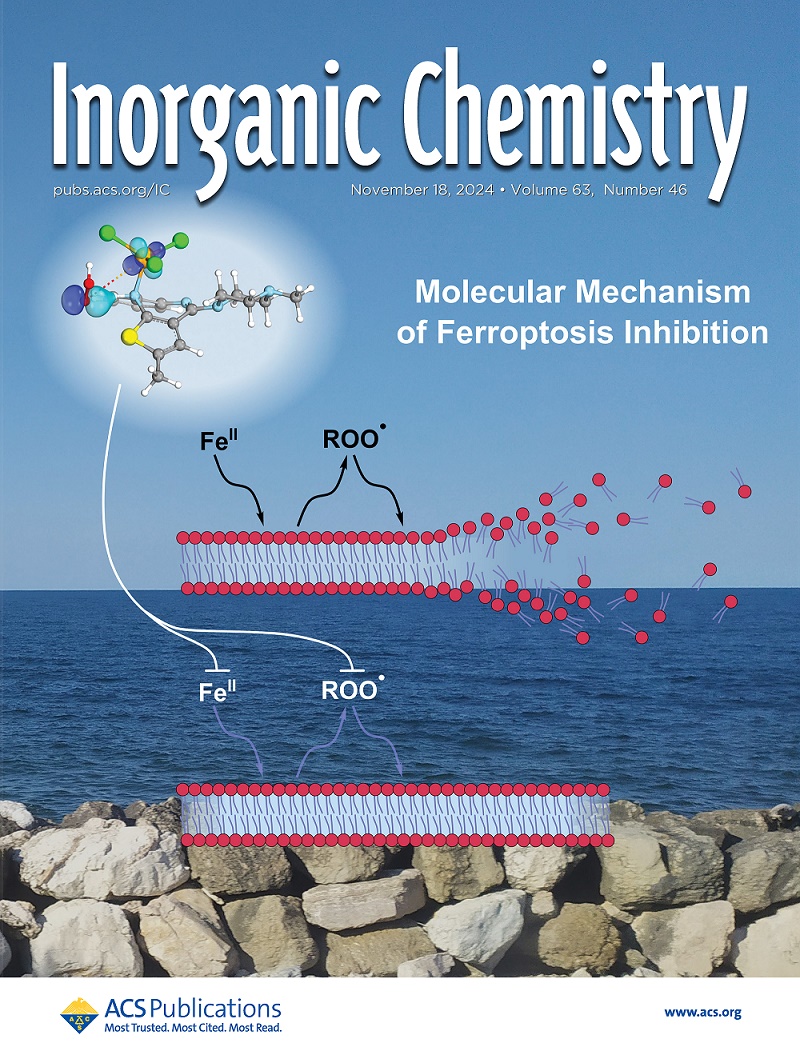The Interplay of Cyclometalated-Ir and Mesoionic Imines: Stoichiometric and Catalytic Reactivities
IF 4.7
2区 化学
Q1 CHEMISTRY, INORGANIC & NUCLEAR
引用次数: 0
Abstract
Triazole-based mesoionic imines (MIIs) make up a new class of compounds that possess ambivalent electronic structures and unusual chemical reactivities. We present here two MIIs that display strong intra- and intermolecular hydrogen bonding. Whereas the former is responsible for the selectivity of C–H activation reactions in these molecules, the latter strongly determines their UV–vis signatures. The cyclometalated iridium complexes with MIIs form either coordinatively unsaturated compounds (with Mes substituents) or undergo dimerization (for Ph substituents) through the “imine-N” atom of the MIIs. The coordinatively unsaturated cyclometalated Cp*Ir-MII complex reacts with several substrates such as PPh3, CO, azide, and ethyl. The CO and, in particular, the ethyl-bound Cp*Ir complex are rare cases of stable and crystallographically characterized Cp*Ir complexes with these ligands. Additionally, the IrCp*-MII complex undergoes double C–H activation through the coordination of a second IrCp* fragment. Intriguingly, the cyclometalated IrCp*-MII complexes react with 3 equiv of an activated alkyne to produce an unusual bicyclic compound that contains one six-membered and one eight-membered iridacycle. Furthermore, the coordinatively unsaturated IrCp*-MII complex is an active transfer hydrogenation catalyst. The first comprehensive report on the reactions of transition metal complexes of MIIs shows the potential of these new ligands in organometallic reactivity.

环甲基化铁和中间离子胺的相互作用:化学计量和催化反应活性
基于三唑的介离子亚胺(MIIs)是一类新化合物,具有矛盾的电子结构和不寻常的化学反应活性。我们在此介绍两种显示出强分子内和分子间氢键的 MII。前者是这些分子中 C-H 活化反应选择性的原因,而后者则在很大程度上决定了它们的紫外-可见光谱特征。环金属化铱配合物与 MII 形成配位不饱和化合物(Mes 取代基)或通过 MII 的 "亚胺-N "原子发生二聚(Ph 取代基)。配位不饱和环甲基化 Cp*Ir-MII 复合物可与多种底物(如 PPh3、CO、叠氮化物和乙基)发生反应。与 CO,特别是与乙基结合的 Cp*Ir 复合物是与这些配体结合的稳定且具有晶体学特征的 Cp*Ir 复合物中的罕见实例。此外,IrCp*-MII 复合物通过第二个 IrCp* 片段的配位发生了双 C-H 活化。耐人寻味的是,环甲基化的 IrCp*-MII 复合物与 3 等量的活化炔发生反应,生成了一种不寻常的双环化合物,其中包含一个六元和一个八元的铱环。此外,配位不饱和 IrCp*-MII 复合物还是一种活性转移加氢催化剂。这是对 MIIs 过渡金属配合物反应的首次全面报道,显示了这些新配体在有机金属反应方面的潜力。
本文章由计算机程序翻译,如有差异,请以英文原文为准。
求助全文
约1分钟内获得全文
求助全文
来源期刊

Inorganic Chemistry
化学-无机化学与核化学
CiteScore
7.60
自引率
13.00%
发文量
1960
审稿时长
1.9 months
期刊介绍:
Inorganic Chemistry publishes fundamental studies in all phases of inorganic chemistry. Coverage includes experimental and theoretical reports on quantitative studies of structure and thermodynamics, kinetics, mechanisms of inorganic reactions, bioinorganic chemistry, and relevant aspects of organometallic chemistry, solid-state phenomena, and chemical bonding theory. Emphasis is placed on the synthesis, structure, thermodynamics, reactivity, spectroscopy, and bonding properties of significant new and known compounds.
 求助内容:
求助内容: 应助结果提醒方式:
应助结果提醒方式:


